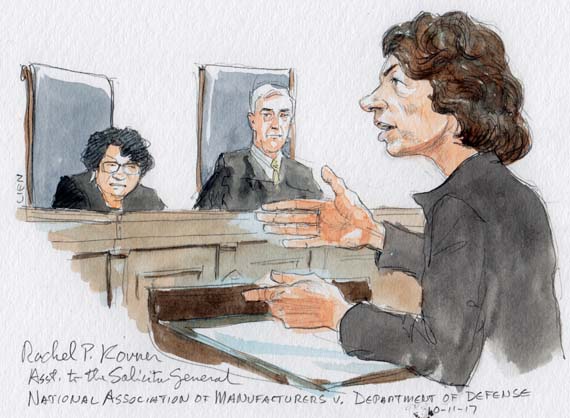Opinion analysis: Challenges to the WOTUS rule must begin in district court

on Jan 22, 2018 at 6:01 pm

The federal government’s attempts to define the statutory phrase “waters of the United States” — and in turn, to establish the geographic reach of the federal government’s regulatory authority under the Clean Water Act — have repeatedly spurred litigation over the years. Most recently, when the Obama administration issued the “Clean Water Rule,” also known as the Waters of the United States Rule, over 100 parties across the country sued to challenge it. In today’s opinion in National Association of Manufacturers v. Department of Defense, written by Justice Sonia Sotomayor, the Supreme Court unanimously held that those lawsuits must be filed in federal district courts rather than federal courts of appeals. Although the decision says nothing about the rule’s merits, it resolves an important procedural and strategic quandary and will have ripple effects beyond this case.
The dispute over the appropriate federal forum is rooted in a provision of the act, 33 U.S.C § 1369(b)(1), which lists certain types of challenges that litigants must file in the federal courts of appeals rather than in the ordinary forum of federal district court. Specifically, Section 13691(b)(1) designates seven types of actions by the Environmental Protection Agency for direct appellate review. The government and its fellow respondents had argued that challenges to the WOTUS rule fell within two provisions of that list: subsection (E), which covers actions “in approving or promulgating any effluent limitation or other limitation under section 1311, 1312, 1316, or 1345 of this title,” or subsection (F), which covers actions “in issuing or denying any permit under section 1342 of this title.” Today’s decision rejects both of those options, requiring litigants instead to file in district court.
As a practical matter, the Supreme Court’s decision means that this litigation, and suits challenging similar Clean Water Act regulations, may be less orderly than they would have been if the government had prevailed. Allowing litigants to file in district courts around the nation may lead to both forum shopping and conflicting district court rulings. At the same time, the court’s decision ends years of jurisdictional confusion in the lower courts. Prior to this ruling, parties routinely filed in both district and appellate courts as a safeguard — in case either forum determined it lacked authority to hear the case in light of Section 1369. Today’s opinion ends that practice, finding that “the statutory language makes clear” that the cases may be filed in district court alone.
As I described in my argument analysis, the justices had expressed skepticism at oral argument about the textual plausibility of the government’s position. The opinion follows suit: The act’s text — and its limits — play the central and pivotal role in the court’s reasoning. With respect to subsection (E), the justices concluded that the WOTUS rule is neither an effluent limitation nor an “other limitation”; it is a definition. The court rejected the government’s contrary argument — that the rule has the “practical effect” of triggering such limits — as “disregarding the statutory text.” And in any event, the rule was not promulgated “under” Section 1311, because Section 1311 does not confer authority to define statutory terms or mention the phrase “waters of the United States.”
The Supreme Court similarly rejected the government’s argument that the rule falls within subsection (F). The court easily concluded that the WOTUS rule — again, a definition of which waters the statute covers — is not an action “issuing or denying” a permit. The government had relied on a prior decision, Crown Simpson Pulp Co v. Costle, to argue that subsection (F) encompasses actions functionally similar to permit denials. But the court distinguished Crown Simpson: Unlike the EPA veto in that case, the rule here “makes no decision whatsoever on individual permit applications.” Thus, the government’s position — “completely unmoored from the statutory text,” the court emphasized — could not prevail.
In the opinion’s final section, the Supreme Court did acknowledge the force of some of the government’s other, nontextual arguments. For one, it is not obviously sensible for challenges to nationwide rules to proceed in district courts nationwide while challenges to individualized permit decisions proceed in a centralized appellate forum. But the court noted that Section 1369’s line-drawing leads to other oddities as well (e.g., it curiously sends some permit decisions to district court and others to appellate court), and it is not the court’s role to rewrite the statute. Second, the court acknowledged that directing WOTUS rule litigation to a single appellate court would yield some efficiency (because appellate courts otherwise review anew the same administrative record the district court considered), and promote uniformity in the law (because district courts may otherwise reach conflicting opinions, as happened here). But, as all nine justices agreed, this was not a case in which deeper purposes or broader policies sufficed to overcome the statute’s text.
[Disclosure: Goldstein & Russell, P.C., whose attorneys contribute to this blog in various capacities, is among the counsel to the respondents in this case. The author of this post, however, is not affiliated with the firm.]


